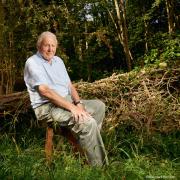In Kent Life’s sixth visit to the centre of our county in International Map Year, we discuss Doodle Bugs and look at V1 Crash Locations in Kent in 1944.
Kent’s location at the narrowest point of the English Channel means that it has been in the front line in many wars, from the Romans onwards. And 72 years ago this month the skies of Kent were filled with a new threat, in the form of the unmanned V1 Doodle Bug flying bomb. This is the basis of this month’s map.
Between September 1940 and May 1941, London, along with many other British cities, including Canterbury, was subjected to intense bombing by the German Luftwaffe.
Kent was in the front line, with the air battle raging overhead, and bombers dumping any unused bombs across our county as they returned from their raids. While London was the objective for much of this activity, parts of Kent were also targeted. Strategic locations such as Dover, the Medway towns and Ashford were attacked, but Canterbury was also hit badly, part of the infamous Baedeker Raids launched in retaliation for the RAF bombing of historically important cities such as Lübeck. These raids were aimed not at military nor strategic sites, but at cultural heritage and based on locations listed as three star in the Baedeker Guide.
In the summer of 1944, London was subjected to a second Blitz. But instead of conventional bombs, the weapons took the form of unmanned V1 Doodle Bug flying bombs, mainly launched from south of Calais and aimed at London.
They were fairly simple devices, being designed to fly in a set direction for a set distance before the engine would cut out, causing the machine to drop out of the sky onto whoever or whatever was below.
Surely the majority of Men of Kent and Kentish Men have heard stories of these devices droning overhead, or even have memories themselves.
One of my grandfathers was a member of the Herne Bay Home Guard and remembers one that was flying over the town when its engine cut out, indicating that it was about to drop.
As it started to descend the wind caught it and carried it into the fields beyond the town (possibly near what is now Thornden Close), where it crashed harmlessly. A very religious man, I remember him telling me that it was God who had saved the town from being hit.
In September 1944, as the Doodle Bug threat was being removed by the advance of the Allied armies in France, the Kent Messenger published a map showing where flying bombs had “crashed” in Kent (see kentmessenger.newsprints.co.uk/view/11072013/doodlebug map layers_jpg).
Some of these would have crashed due to a mechanical failure, but the majority would have been brought down by anti-aircraft guns, barrage balloons or RAF fighters, which would bravely fly up to the bombs and tip them with their own wing tips. As indicated on the map, so many bombs were brought down over Kent that the area was dubbed Bomb Alley.
However, after studying the old black and white print I wanted to try recreating it using modern, computerised, techniques to enhance it to give a more vivid impression of what was happening in Kent at this time.
The first step was to scan the paper map into the Geographical Information System program for creating maps on the computer. Once this had been done, I was able to copy each crash site as an individual point. The software was then able to generate a density, or Hot Spot map, which I have superimposed onto the original image. Red (Hot) areas have the greatest density of crash sites, while the blue areas have the lowest.
This map shows that Bomb Alley was not all of Kent, but the south and west of the county. Intriguingly, the Heart of Kent (shown on the map as a black dot), near Lenham, sits right on the cusp of the two areas with the areas to the north and east seeming to be relatively peaceful.
I must say that my grandfather always felt that he had done his bit, spending many freezing cold nights on patrol, waiting to meet a German invasion, seeing and hearing bombers, and even a Doodle Bug or two, coming and going.
However, I can’t help feeling that he was, in fact, just about as safe as someone could be in our battered county.
Pinpointing the centre
“Imagine cutting out a map of Kent and trying to balance it on a pin. When it is perfectly balanced, you would have found the county’s centre of gravity.
The centre is found at TQ 902 514 on the OS map, just to the south east of Lenham, and on the Stour Valley Walk. This is based on the map of Kent with Medway. Another option could be to calculate the centre Kent based on its population (which pulls the centre of gravity towards Medway), and results in a centre at TQ 868 596, close to Bicknor (south of Sittingbourne).”
Prof. Peter Vujakovic, Canterbury Christ Church
w



























